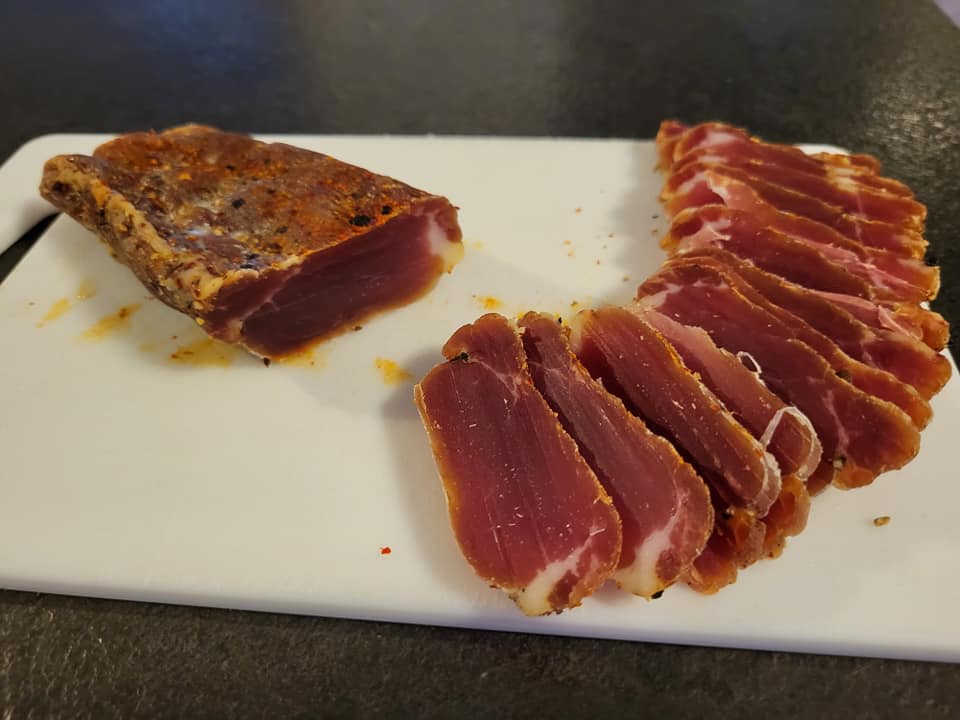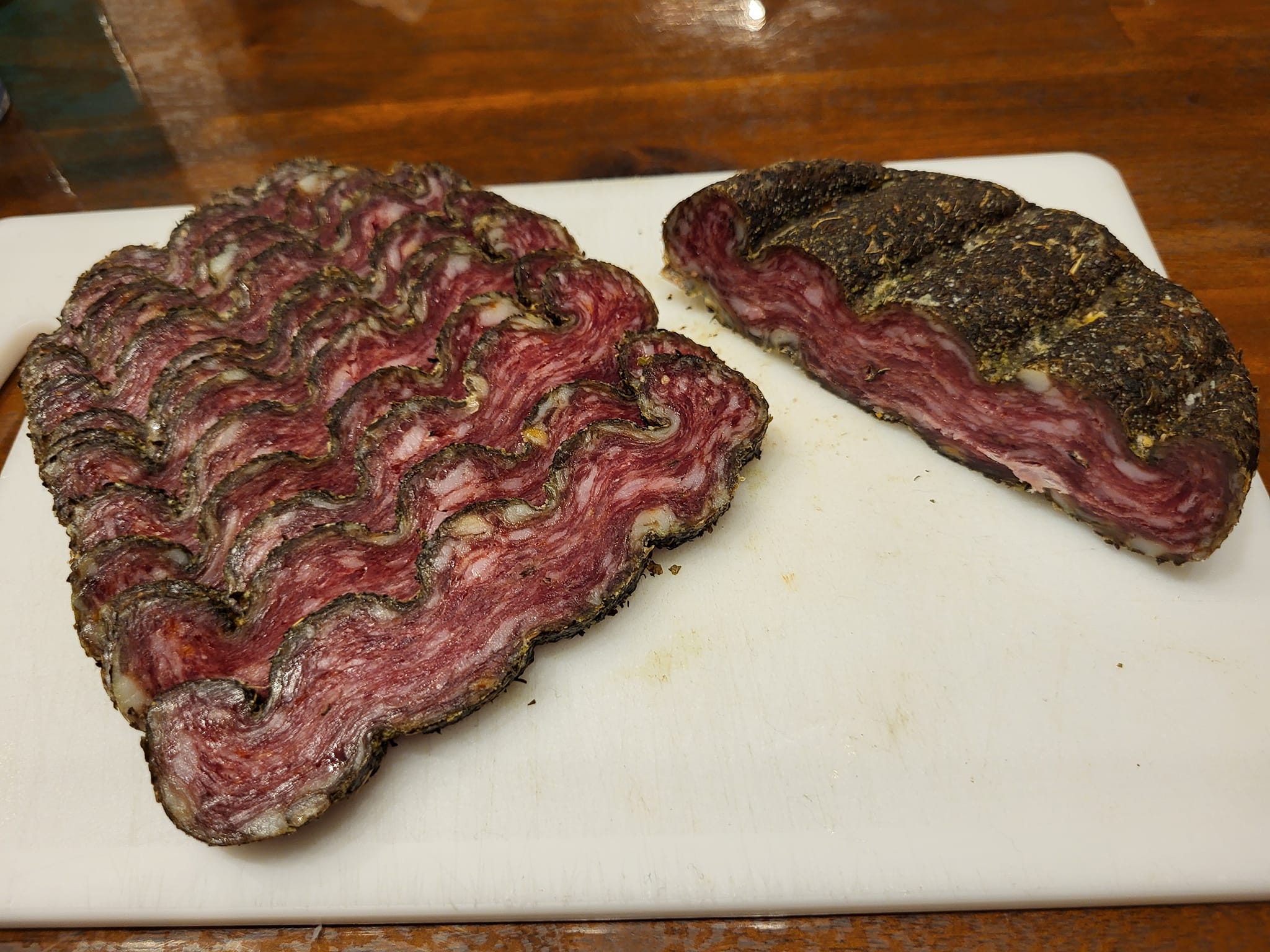The classic Basque Béret recipe—your easiest homemade charcuterie project
The Basque Béret, a Camembert-shaped delicacy, showcases the authenticity and culinary creativity of the Basque Country. More than a sausage, it celebrates artisanal expertise and safeguards a unique gastronomic heritage.

If you’re passionate about traditional homemade charcuterie and time-honored methods, this recipe reveals the secrets behind the famous Basque Béret. But first, let’s explore its history and its role in preserving Basque identity.
Basque Béret History: A Culinary and Cultural Icon
Created in 2003 by Maison Mayté, the Basque Béret has become a flagship of local charcuterie. Its name and round, flattened shape pay homage to the iconic Basque cap. Made in Saint-Jean-le-Vieux, Lower Navarre, this casing-free sausage—seasoned with black pepper or Espelette chili—is crafted exclusively from 100 % Basque pork.

Yet this newcomer quickly sparked the so-called “sausage war.” Industrial producer Loste released a look-alike called the “Pavé basque,” borrowing Basque imagery while using non-local pork.
Maison Mayté fought back to protect both its invention and the integrity of Basque products. “Why not call their sausage the ‘Pavé de la Haute-Loire’?” quipped Éric Mayté, capturing the sense of cultural appropriation.
The dispute exposed a larger issue: the “Basque Country” label lacks legal protection. For discerning gourmets, however, telling a true Basque Béret from an impostor is easy—the superior taste and meat quality speak for themselves.
Tips for a Perfect Basque Béret
Techniques for Crafting Your Basque Béret
More Than a Recipe—A Craft
Preparing a Basque Béret at home means entering the world of artisanal charcuterie. Think of it less as a strict recipe and more as a method to master—one that rewards careful technique with rich, nuanced flavor.

Use Non-Iodized Salt
Iodine can disrupt fermentation. To safeguard aroma and texture, always choose non-iodized salt—an essential in home charcuterie.
Add Starter Cultures for an Ideal Microbial Flora
Starter cultures such as Bioferm 600 and Sax-01—available from suppliers like Testek—promote a healthy microflora and limit oxidation. They’re optional, but they boost safety and lend authentic flavor. Use them only if you have them on hand or if the process feels daunting.
Watch Humidity and Temperature Closely
- Fridge: Lay your bérets on a rack in a well-ventilated refrigerator. Turn them regularly—especially during the first few days—for even drying.
- Wine cellar: A ventilated cellar kept at 14 °C with 74 % humidity also works beautifully.
Avoid Drying Pitfalls
If the bérets aren’t compressed firmly or if the rack mesh is too fine, trapped air can slow drying. Keep humidity steady as well to prevent premature oxidation or uneven microbial growth.
Monitor Weight Loss
Aim for 45–50 % weight loss. A raw 200 g béret, for instance, should weigh about 100 g when fully dried. Underdrying results in milder flavor and a shorter shelf life.
Recipe contributed by Cé-line

Authentic Basque Bérets
Ingredients
- 700 g Pork shoulder
- 300 g Pork belly
- 35 g Salt
- 1 g Ground white pepper
- 2 g Ground black pepper
- 4 g Four-spice blend (quatre-épices)
- 1 g Dried coriander leaves
- 0.5 g Freshly grated nutmeg
- 2 g Granulated sugar
- 1 g Garlic powder
- 2 g Ground Espelette pepper
Procédé
Grinding the meat
- Grind the pork shoulder and belly using an 8 mm plate.700 g Pork shoulder, 300 g Pork belly
Mixing the ingredients
- In a large bowl, or in the bowl of a stand mixer fitted with the paddle attachment, combine the ground meat with the salt, spices, coriander, nutmeg, sugar, garlic, and Espelette pepper.35 g Salt, 1 g Ground white pepper, 2 g Ground black pepper, 4 g Four-spice blend (quatre-épices), 1 g Dried coriander leaves, 0.5 g Freshly grated nutmeg, 2 g Granulated sugar, 1 g Garlic powder, 2 g Ground Espelette pepper
- Mix thoroughly until the seasonings are evenly distributed.
Resting the mixture
- Refrigerate the mixture for at least 12 hours; this rest develops flavor and makes shaping easier.
Shaping the bérets
- Divide the mixture into 350 g portions.
- Shape each portion into a disk roughly ¾ cm thick, like a small camembert. A plunger-style cutter is helpful—you’ll need to press firmly to force out any trapped air.
Drying
- Arrange the bérets on wire racks, leaving just enough space so they don’t touch yet still allow good airflow. Choose racks with a tight grid; without a casing, the meat can sag through wide gaps and let air pockets form.
- The aim is perfectly even drying.
- Drying target: Aim for about 50 % water loss. For example, a 200 g raw béret should weigh around 100 g when fully dried. A reduction of 45–50 % strikes the ideal balance between flavor and shelf life; anything less results in milder taste and shorter keeping time.
Fridge drying
- Set the rack of bérets on the lowest shelf of a well-ventilated refrigerator. Dry for 4 weeks, turning them regularly, especially during the first few days.
Wine cellar option
- You can also use a well-ventilated wine cellar. Maintain the temperature at 14 °C with 74 % humidity for optimal drying.
Notes
Experiment with different drying levels to suit your taste, but for the fullest cured-meat flavor aim for a 50 % water loss.
